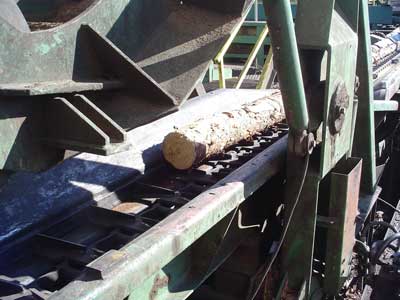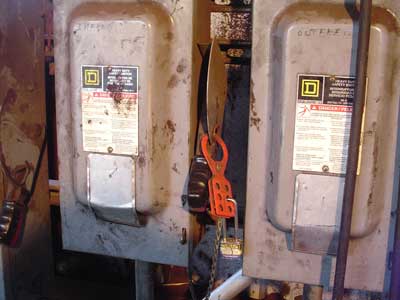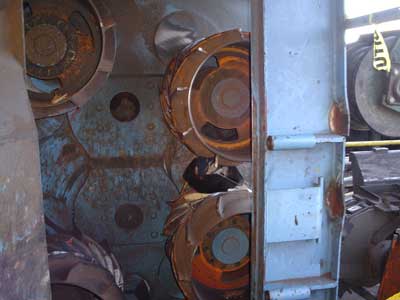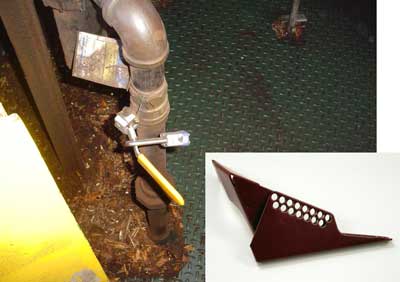Millwright Killed When Pinned Between the Feed Rolls of a Debarker during Machine Maintenance - South Carolina
NIOSH In-house FACE Report 2006-02
March, 16, 2007
Summary
On January 17, 2006, a 52-year-old millwright (the victim) was fatally injured when he was pinned between the feed rolls of a debarker as he was welding additional metal to the teeth on the feed rolls. The victim had locked out two electrical disconnects in the debarking room before beginning his work, but he had not locked out all electrical disconnects and had not shut off and locked out the air line to the machine. As the victim welded, he leaned forward and placed his head between the upper and lower feed rolls to reach areas that required more metal. The air pressure on the rolls automatically cycled and the feed rolls closed over the victim’s head.
The victim had been working alone. His supervisor had left the area to check on another machine. When the supervisor returned to the area about 20 to 30 minutes after he had last seen the victim, he found that the victim had been caught in the machine. The supervisor called on the company radio for help and for someone to call 911. He then turned off the air line. When he returned, he and other employees used a chain jack, commonly referred to as a “come-along,” to lift the upper feed roll off of the victim. They removed him from the machine and placed him on the floor next to the machine. Emergency medical services (EMS) personnel arrived approximately 20 minutes after receiving the 911 call and attempted to do cardiopulmonary resuscitation but to no effect. They called the coroner who came to the site and pronounced the victim dead.
NIOSH investigators concluded that, to help prevent similar occurrences, employers should
- ensure that hazardous energy control safety procedures clearly identify all potential sources of energy for each machine and that the location and the method for control is clearly identified. Workers should be routinely trained on the procedures.
- Ensure that all hazardous energy, including pneumatic energy, is locked out, and any stored energy is released before repair work begins.
- Follow the equipment manufacturers’ recommendations for removal, maintenance, repair, and/or replacement of machine parts.
- Ensure that employees are adequately trained and supervised when assigned to perform new, infrequent, or dangerous tasks.
- Contact the equipment manufacturer for assistance in redesigning machine systems to reduce the number of lockouts needed to render the equipment safe for repair and maintenance.
Introduction
On January 17, 2006, a 52-year-old millwright (the victim) was fatally injured when he was pinned between the feed rolls of a debarker as he was welding additional metal to the teeth on the feed rolls. On March 17, 2006, the South Carolina Occupational Safety and Health Administration (SCOSHA) notified the National Institute for Occupational Safety and Health (NIOSH), Division of Safety Research (DSR), of the incident. On May 8, 2006, a DSR safety and occupational health specialist met with the county coroner and investigating deputy sheriff. The DSR safety and occupational health specialist traveled to the company headquarters on May 8, 2006, but the safety manager was not available and subsequent phone calls were not returned. On May 9, 2006, the SCOSHA compliance officer assigned to the incident was interviewed by telephone. The sheriff’s report and the county coroner’s report were reviewed. This report is based on findings obtained from a review of official reports. The cause of death was obtained from the county coroner’s report.
Employer
The victim’s employer, a lumber mill, employed 153 employees and had been in business since 1981.
Victim
The victim was employed as a millwright and had worked for the company for two years. He was trained in general lockout/tagout procedures at the jobsite. Welding was one of the victim’s job duties.
Equipment
The debarker was one of two debarkers used at the lumber mill. It was not known to have any apparent mechanical problems, but the teeth were worn down. According to the debarker manufacturer, the debarker was built in 1962. The company had owned the debarker for several years, but its date of purchase was not obtained by investigators.
Safety Program and Training
The victim’s employer had a written safety and health and training program, but the hazardous energy control procedures were not sufficient to completely de-energize and lockout the debarker. The company procedures for lockout/tagout did not address where to lock out each of six electrical energy sources and one pneumatic energy source for the debarker. The company had a full time safety manager and held monthly safety meetings.
This was the employer’s first workplace fatality.
Back to Top
Investigation
The incident site was a large lumber mill that processed southern yellow pine logs. The logs were transported by truck, weighed on scales, then stored on outdoor runs. The logs were then loaded on conveyors, debarked, and sawed into lumber. The lumber yard was designed with two process lines (north and south). Each of the debarkers had two sets of 3-foot by 3-foot top and bottom feed rolls that removed bark from logs as they passed through on a conveyor (Photo 1). The system was powered by 480 volts of electricity and pneumatic pressure was used to move rolls up and down. After the lumber was kiln dried it was sold for commercial and residential home use. Approximately 26 tons of logs were debarked at the lumber mill per day. The lumber mill ran two shifts: 6 a.m. to 3:30 p.m. and 7 p.m. to 4:30 a.m. Repairs and major maintenance procedures were conducted during shut down from 3:30 p.m. to 7:00 p.m.

|
|
Photo 1. This photograph illustrates the conveyor moving logs into the south debarker |
On the day of the incident, the victim began his shift at 6 a.m., attended a monthly safety meeting, and spent the day performing various maintenance jobs. It was a routine day at the mill. At the end of his normal shift (3:30 p.m.), the victim remained at work to do maintenance on the teeth of the feed rolls on the south debarker. His assignment was to weld additional metal to the teeth on the feed rolls. He had not conducted this type of repair before the day of the incident.
According to the SCOSHA compliance officer, there were six electrical lockouts and one pneumatic energy source that needed to be locked out and stored pneumatic energy released before the feed rolls on the south debarker could be accessed for repair work.
The victim locked out two electrical systems at their source (Photo 2) in the debarker room using his personally assigned locks. It is not certain how many locks the victim had in his possession but he did not lock out the four additional electrical or one pneumatic disconnect, nor did he bleed the air lines to release stored energy. He was wearing a hard hat and a face shield designed specifically for welding. Given the location of the victim’s welding shield after the incident, it appears that he positioned his head into an area between the top and bottom rollers (Photo 3). Coworkers estimated that he had welded about 10 minutes on the job (which was estimated to take about 30 minutes) when the air pressure that controls the up and down motion of the feed rolls automatically activated and the rolls closed over his head causing fatal injuries.

|
|
Photo 2. This photo illustrates the south debarker room where locks had been placed on two electrical circuits by the victim |

|
|
Photo 3. This photo illustrates the feed rolls of the south debarker where the victim had been welding metal onto the debarker teeth. [Photo courtesy of SCOSHA]. |
The company’s written procedures for the south debarker did not clearly outline techniques to completely control all sources of hazardous energy for this equipment. The written procedures indicated that workers were to go to the room under the saw booth and position breakers in the “off” position. The procedures did not indicate that locks must be used to ensure that the electrical system remained disconnected. The procedure also instructed workers to “lock out the air valve located at the right-bottom side of the debarker.” In reality, the location of this air valve that must be locked out (Photo 4) is accessed by first leaving the area at the front of the south debarker, walking up steps to access a metal catwalk, walking 20 feet on the catwalk, and going down steep steps to the backside of the debarker. The air valve is not visible to an operator working at the front side of the debarker, and the machine-specific lockout/tagout procedures did not specifically document its location. Additionally, written procedures did not identify specific procedures for bleeding, blocking, and verifying that stored pneumatic pressure was rendered safe. In addition, the procedures did not clearly state that each lock used to secure an energy control device must be clearly labeled with a durable tag to identify the worker assigned to the lock.

|
|
Photo 4. This photo illustrates the air line that supplied the debarker and is not properly locked out [courtesy of SCOSHA]. The insert illustrates an example of a ball valve lockout device that can be used to lock out the pneumatic airline. The manufacturers’ directions for installing any lockout device must be followed. |
There were danger signs on the south debarker. A two-part danger sign posted on the south debarker used both pictures and words. One side of the sign had a picture of a lock on it and wording under the lock said “LOCK IT OUT BEFORE CLEANING OR MAINTENANCE.” The other side of the sign pictured a hand with fingers cut through and wording under the picture said “THIS MACHINE IS AUTOMATICALLY CONTROLLED AND MAY START AT ANY TIME.”
The victim had been working alone. His supervisor had left the area to check on another machine. When the supervisor returned to the area about 20 to 30 minutes after he had last seen the victim, he found him caught in the machine. The supervisor called on the company radio for help and for someone to call 911. He then went to the backside of the debarker up the catwalk and turned off the air line.
When the supervisor returned from shutting off the air pressure, he and other employees used a chain jack, commonly referred to as a “come-along,” to lift the upper feed roll off of the victim. They removed him from the machine and placed him on the floor. The victim’s welding shield was still between the two feed rolls when the victim was removed. EMS arrived approximately 20 minutes after receiving the 911 call and performed cardiopulmonary resuscitation, but to no effect. They called the coroner who came to the site and pronounced the victim dead. The coroner determined that the victim died almost immediately after he was injured, and documented on his report that the time of death was 5:16 p.m.
Back to Top
Cause of Death
The coroner’s office reported that the cause of death was traumatic brain injury with cerebral edema and basilar skull fracture.
Recommendations/Discussion
Recommendation #1: Employers should ensure that hazardous energy control safety procedures clearly identify all potential sources of energy for each machine and that the location and the method for control is clearly identified. Workers should be routinely trained on the procedures.
Discussion: Employers must, at a minimum, follow all Occupational Safety and Health Administration (OSHA) standards for the control of hazardous energy (lockout/tagout) which are located in 29 CFR 1910.147.1
Although the victim’s employer had a manual that contained written hazardous energy control procedures that specifically addressed the south debarker, the procedures did not clearly outline techniques to be used to completely control all sources of hazardous energy. The procedures also did not contain the specific location where electrical and pneumatic disconnects were located or specific procedures for bleeding, blocking and verifying that stored pneumatic pressure was rendered safe. The procedures should clearly state how workers are to obtain sufficient locks and keys to lock out all hazardous energy sources present, that durable tags are to be used to identify the worker assigned to the lock, and identify the methods to be used to verify that all stored energy has been released. Posting a machine specific drawing that identifies each electrical disconnect location and pneumatic pressure control location might assist employees as they prepare to ready the machine for repairs.
Supervisors and other employees should be routinely trained on OSHA’s lockout/tagout procedures (29CFR 1910.147(c)(7).2 Useful information for safety training for workers who work around uncontrolled hazardous energy can be found in the NIOSH ALERT entitled Preventing Worker Deaths from Uncontrolled Electrical, Mechanical, and Other Types of Hazardous Energy,3 which can be found at the NIOSH web site at https://www.cdc.gov/niosh/99-110.html or by calling 1-800-356-4674. The Alert contains a tear-out sheet (PDF format) that summarizes safety precautions for workers who work near hazardous energy. Posting this tear-out sheet at the worksite may serve as an additional means of communicating safe work procedures to workers. Employers should ensure that all workers who are assigned to work around hazardous energy are trained to follow all standards found in Occupational Safety and Health Administration (OSHA) 29 CFR 1910.147 [The Control of Hazardous Energy (lockout/tagout)].1
Recommendation #2: Employers should ensure that all hazardous energy, including pneumatic energy, is locked out, and any stored energy is released before repair work begins.
Discussion:Discussion: Employers should consider requiring workers to use a machine specific checklist signed by the employee and their supervisor indicating that locks and tags have been placed on all disconnects as this documentation would act as a reminder to ensure that all energy sources to machines are controlled and locked/tagged out. A diagram showing all machine specific disconnects should be an integral part of the checklist. When employees are performing a procedure for the first time, this checklist could provide an opportunity for supervisors to reassess the employee’s understanding of lockout/tagout procedures and to correct them, if needed, before repair work begins.
The lockout/tagout procedures checklist provided in the Appendix (page 10 of this document) is an example of a checklist developed by OSHA for small businesses. These materials are also available at https://www.osha.gov/Publications/smallbusiness/small-business.html#checkexternal icon (Link updated 12/11/2007) or can be obtained by contacting an area OSHA office and requesting the Small Business Handbook.4 This sample checklist can be used as a guide by companies striving to develop a machine-specific lockout/tagout checklist.
Recommendation #3: Employers should follow the equipment manufacturers’ recommendations for removal, maintenance, repair, and/or replacement of machine parts.
Discussion: Debarkers have large rolls that have teeth on them that remove bark from logs. These teeth wear out over time. The rolls are not easily accessed and move under electrical and air power. The DSR investigator spoke with a manufacturer’s representative (personal communication July 18, 2006) who reported that the manufacturer recommends that the rolls not be repaired onsite, but instead that a manufacturer’s representative be called to remove and replace the worn feed rolls. The manufacturer’s representative further reported that adding metal to the teeth on feed rolls onsite is a task that is done on an infrequent basis to keep the mill running, but it is dangerous and is not recommended.
Recommendation #4: Employers should ensure that employees are adequately trained and supervised when assigned to perform new, infrequent, or dangerous tasks.
Discussion: Discussion: Employees assigned to maintenance and repair tasks should be adequately trained in lockout/tagout procedures.2 When they are assigned to new tasks, tasks that are performed infrequently, or tasks located in extremely hazardous locations, employees should be carefully and continuously supervised to ensure that appropriate control procedures are followed.
Recommendation #5: Employers should contact the equipment manufacturer for assistance in redesigning machine systems to reduce the number of lockouts needed to render equipment safe for repair and maintenance.
Discussion: A redesign of the system that reduces the number of lockouts needed to render the system safe for repair and maintenance, for example one master electrical lockout and one air valve lockout, may make it easier for workers to effectively lock out all energy sources. As part of the redesign, consideration should be given to relocating the air valve to make access easier.
Back to To
References
- Code of Federal Regulations [2005]. 29 CFR 1910.147: The control of hazardous energy. Washington, DC: U.S. Government Printing Office, Office of the Federal Register.
- Code of Federal Regulations [2005]. 29 CFR 1910.147(c)(7): Training and communication. Washington, DC: U.S. Government Printing Office, Office of the Federal Register.
- NIOSH [1999]. Alert: Preventing Worker Deaths from Uncontrolled Release of Electrical, Mechanical, and Other Types of Hazardous Energy. Cincinnati, OH: U.S. Department of Health and Human Services, Public Health Service, Centers for Disease Control and Prevention, National Institute for Occupational Safety and Health, DHHS (NIOSH) Publication No. 99-110.
- OSHA[2005]. Small business handbook. Washington, DC: OSHA Small Business Safety and Health Management Series, OSHA 2209-02R. Date accessed: September 28, 2005 at https://www.osha.gov/Publications/smallbusiness/small-business.html#check external icon(Link updated 12/11/2007)
Investigator Information
This investigation was conducted by Doloris N. Higgins, Safety and Occupational Health Specialist, Fatality Investigations Team, Surveillance and Field Investigations Branch, Division of Safety Research, National Institute for Occupational Safety and Health.
Appendix
SAMPLE LOCKOUT/TAGOUT PROCEDURES CHECKLIST
Abstracted from OSHA Small Business Handbook4
- Is all machinery or equipment capable of movement required to be de-energized or disengaged and blocked or locked out during cleaning, servicing, adjusting, or setting up operations?
- If the power disconnect for equipment does not also disconnect the electrical control circuit, are the appropriate electrical enclosures identified and is a means provided to ensure that the control circuit can also be disconnected and locked out?
- Is the locking out of the control circuits instead of locking out main power disconnects prohibited?
- Are all equipment control valve handles provided with a means for locking out?
- Does the lockout procedure require that stored energy (mechanical, hydraulic, air, etc.) be released or blocked before equipment is locked out for repairs?
- Are appropriate employees provided with individually keyed personal safety locks?
- Are employees required to keep personal control of their key(s) while they have safety locks in use?
- Is it required that only the employee exposed to the hazard can place or remove the safety lock?
- Is it required that employees check the safety of the lockout by attempting a startup after making sure no one is exposed?
- Are employees instructed to always push the control circuit stop button prior to re-energizing the main power switch?
- Is there a means provided to identify any or all employees who are working on locked-out equipment by their locks or accompanying tags?
- Are a sufficient number of accident prevention signs or tags and safety padlocks provided for any reasonably foreseeable repair emergency?
- When machine operations, configuration, or size require an operator to leave the control station and part of the machine could move if accidentally activated, is the part required to be separately locked out or blocked?
- If equipment or lines cannot be shut down, locked out and tagged, is a safe job procedure established and rigidly followed?
